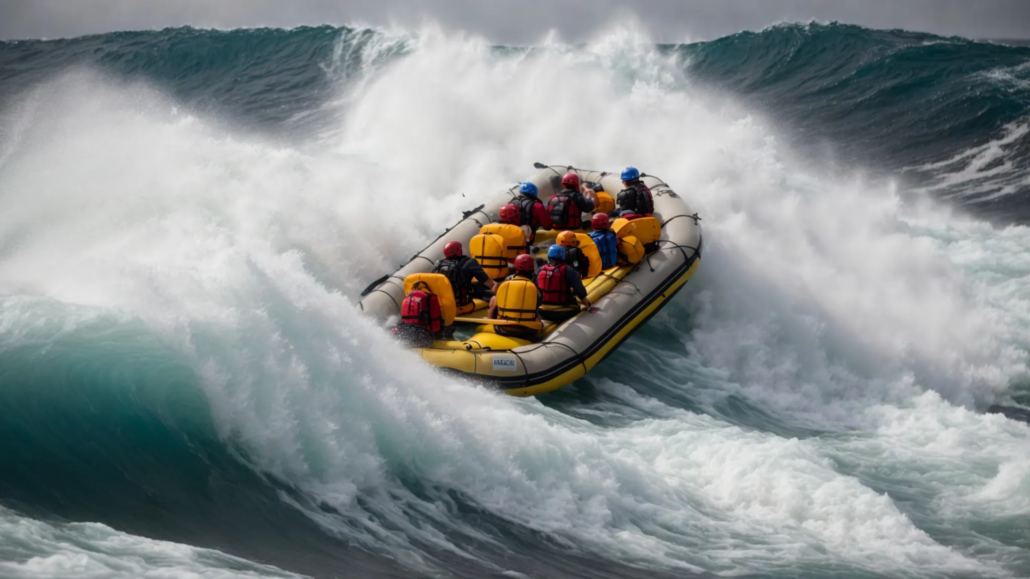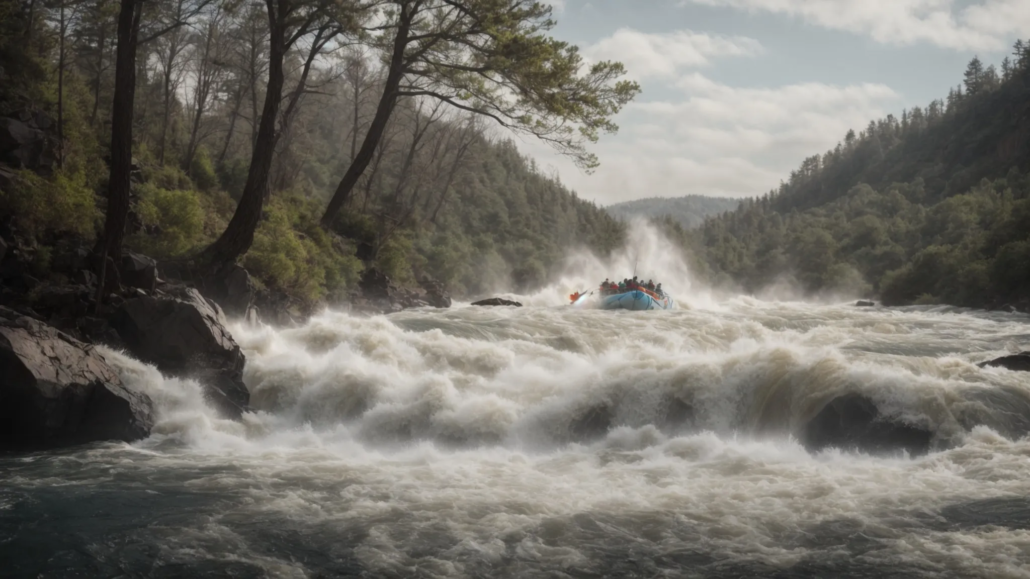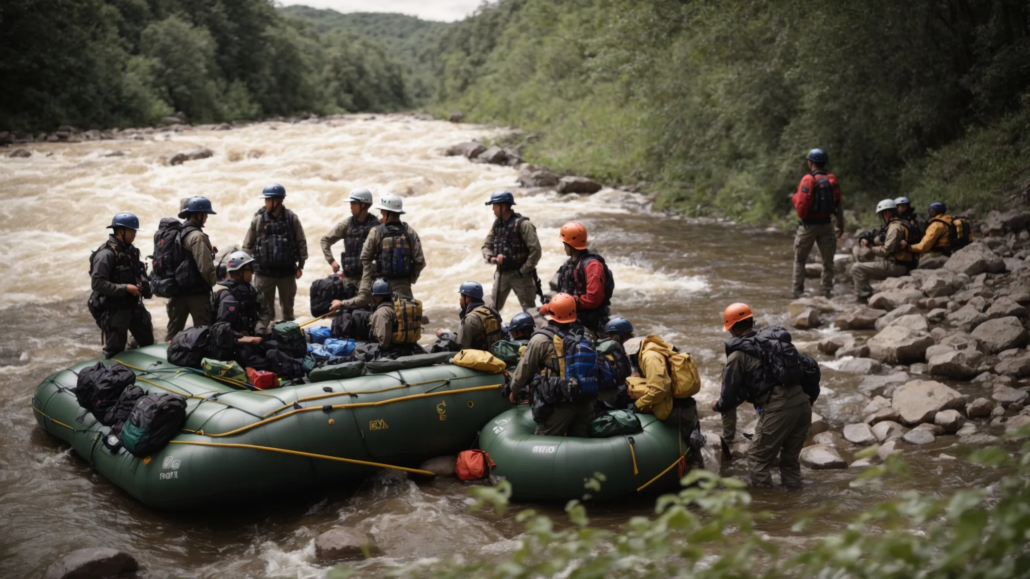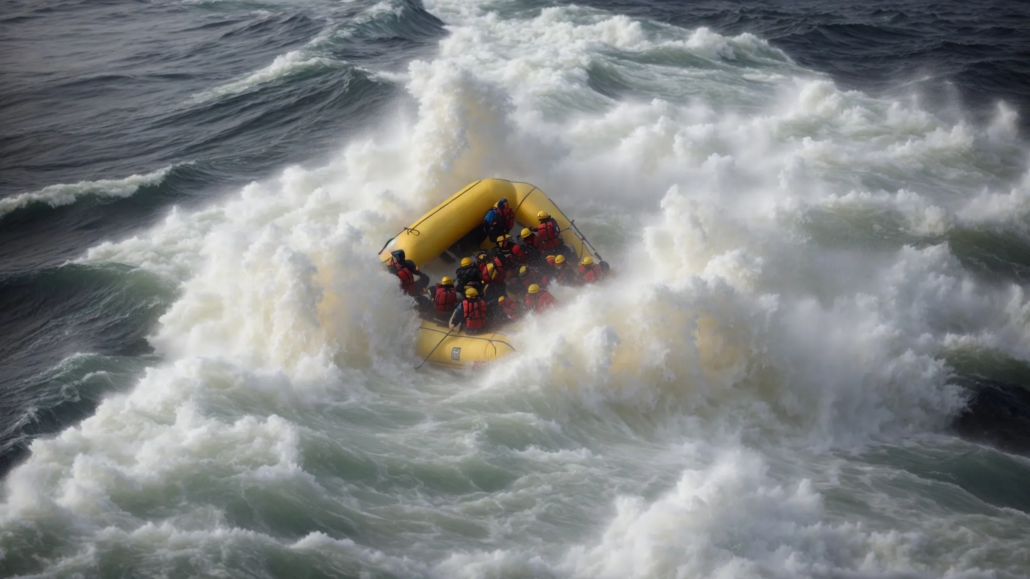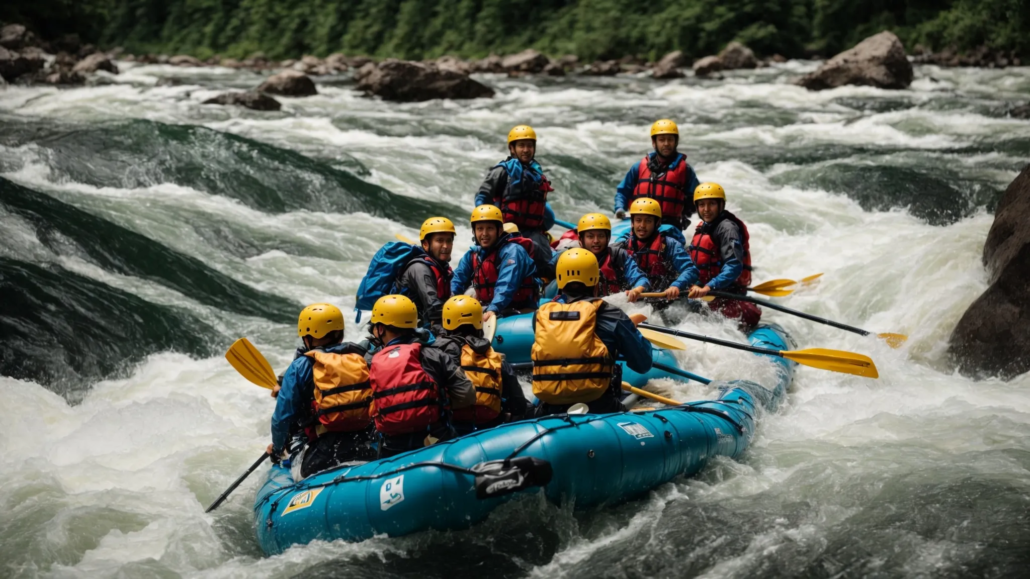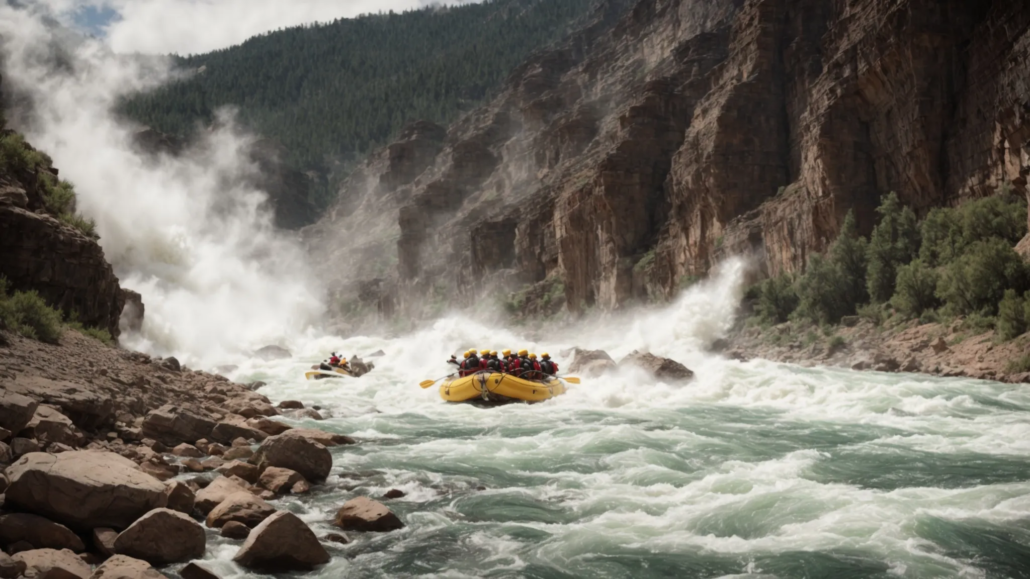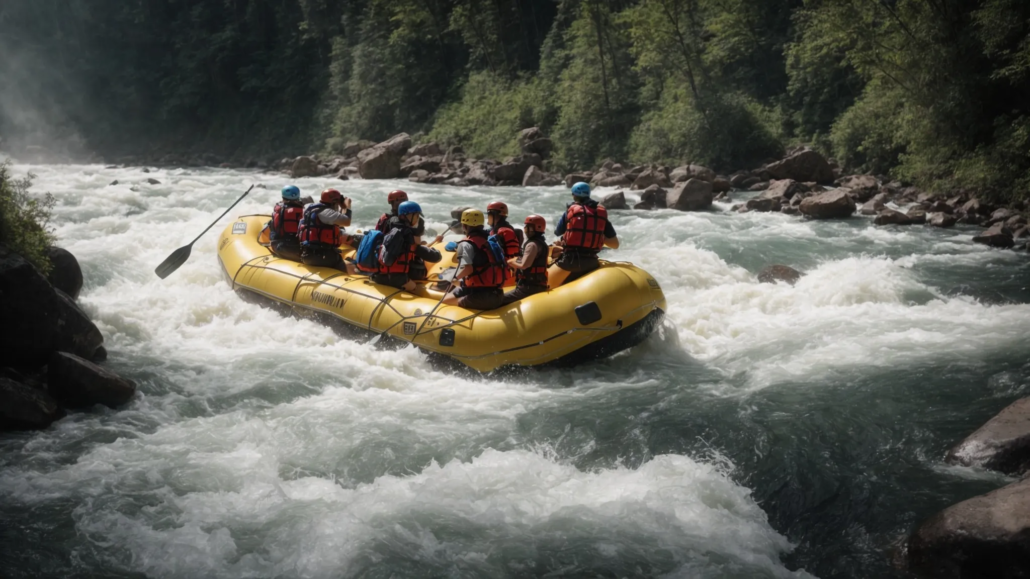The Thrills and Challenges of Class 4 Whitewater Rafting
Tucking my paddle under my arm as the raft bobs like a cork, I’ve come to appreciate the dance with Class 4 rapids as something between art and survival.
There’s a fine line that runs through these waters, one where exhilaration meets risk head-on amidst crashing waves and the roar of water.
Class 4 whitewater rafting isn’t just about holding on for dear life; it’s a deliberate plunge into the heart of the river’s power, guided by skill, respect for the environment, and an insatiable longing for adventure.
As you plot your course through these tumultuous waters, remember that the lessons learned here ripple far beyond the river’s edge.
Keep reading to discover how to embrace the wild rhythm of Class 4 rapids, where every stroke is a story, and every crash against the waves, a testament to the thrill of the ride.
Understanding the Intensity of Class 4 Rapids
Leaping into the heart-pounding, exhilarating realm of Class 4 rapids, the adventure amplifies, pushing the exhilaration to new heights.
What distinguishes these tumultuous waters from their milder counterparts isn’t just their ferocity but also the intricate dance between water volume and the slope of the riverbed.
Here, amid the roar of whitewater, we discover the essence of Class 4 rapids.
The unyielding currents, the steep gradients, and the substantial volume of water combine to create a challenge that demands respect, skill, and a zest for adventure.
Each paddle stroke through these rapids is a testament to the wild spirit of the river, offering a thrilling blend of risk and reward.
With eyes wide, heart racing, and paddle ready, understanding these forces of nature becomes not just about navigating the water but also about embracing the untamed beauty of the wilderness.
What Sets Class 4 Rapids Apart From Others
Before I faced the roaring torrents of Class 4 whitewater, I imagined them as mere ripples on a vast, serene lake. But standing on the edge, gazing into the swirling chaos where the water slammed against rocks and twisted down steep drops, reality set in. The distinguishing factor of Class 4 rapids is their relentless, unpredictable nature, sculpted by rapid drops and tight channels that demand an unwavering focus and an adventurous heart willing to dance with danger.
The first time my raft plunged into the heart of such rapids — amid the rugged landscapes of places like the thrilling Salmon River in Idaho or the granite-clad canyons of California’s Tuolumne River — I realized what sets them apart. It’s not just the technical difficulty or the frothy, white-capped waves that thrill and challenge rafters. It’s the raw, uncontrollable power of water unleashed from snow-capped mountain heights, demanding respect, quick thinking, and precise paddling to navigate successfully. Class 4 rapids teach you to listen, adapt, and ultimately become one with the river’s wild rhythm.
Identifying the Main Characteristics of Class 4 Rapids
Setting off to conquer Class 4 rapids, I quickly learned the essential characteristics that define these tumultuous flows. They are wild, marked by sudden drops and complex turns that test your mettle and ability to keep the raft on course amid chaos.
Their unpredictability is a siren call for adventurers like me, seeking the thrilling challenge of navigating waters that demand both technical prowess and a fearless spirit. It’s in these moments, as the raft dips and soars, that the true essence of Class 4 whitewater unveils itself – a test of endurance, quick decision-making, and harmony with the relentless power of nature.
The Role of Water Volume and Gradient in Class 4 Rapids
The thrill of conquering Class 4 rapids isn’t just about maneuvering through the tumultuous waters; it’s about understanding the dramatic interplay between the river’s water volume and its gradient. As I guided my raft over these roaring waters, the sheer volume of frothing whitewater and the steep gradient combined to create a fierce force that both challenged and exhilarated me, reminding me of the river’s untamed spirit.
With each expedition, whether it was on the mighty Colorado River or through the remote wilderness of Oregon’s Rogue River, I learned that the gradient not only determines the speed of the water but also its behavior as it crashed over rocks and through tight canyons. This knowledge became as essential as my paddle in hand, helping me anticipate the river’s ever-changing moods and navigate my raft through the heart-stopping drops and powerful currents that define Class 4 rapids.
Preparing for Your Class 4 Whitewater Adventure
Stepping up to embrace the wild heart of Class 4 whitewater rafting, preparations ascend beyond mere excitement into a realm of essential readiness.
Sharpening your focus, gauging the symphony of gear that will serve as your lifeline, sculpting your physique and mind into instruments of resilience, and weaving the fabric of unbreakable teamwork and seamless communication – these become your mantras.
Diving into this checklist translates into wielding knowledge as your paddle, ensuring that when the river roars beneath, you and your crew are an unstoppable force, harmonized with the unpredictable cadence of waters that refuse to be tamed.
Essential Gear Checklist for Class 4 Rafting
Locking gazes with the relentless surge of Class 4 rapids, I knew my gear would spell the difference between triumph and humility. A robust wetsuit guarded against the icy clutch of water, a helmet deflected the biting kiss of rocks, and life jackets, akin to steadfast guardians, promised buoyancy amidst the river’s wild embrace.
Grasping my paddle with confidence, I understood it as more than an extension of my arms—it was my key to conversing with the river, guiding our raft through its tumultuous heart. Safety items like a whistle and knife, tucked securely on my person, and the raft guide’s swift water rescue knowledge served as silent sentries against the unforeseen, ready to spring into action should the river challenge us beyond anticipation.
Physical and Mental Preparation Tips
Embarking on a Class 4 whitewater rafting journey isn’t for the faint of heart; it demands a cocktail of physical grit and mental fortitude. Every muscle in your body needs to be primed for the intense effort of paddling and maneuvering, while your mind must be a fortress, unyielded by the impending rush of adrenaline and fear.
As the river’s roar beckons daring spirits, standing strong both body and soul isn’t just advisable; it’s necessary. Conditioning oneself through rigorous training ensures your body can withstand the physical demands, but it’s the mental rehearsal of swift, decisive actions and maintaining calm in chaos that transforms a daunting challenge into a victorious conquest.
Understanding the Importance of Teamwork and Communication
Venturing into the heart of Class 4 whitewater, the unspoken language of teamwork and communication becomes your most invaluable ally. It’s in the furious dance of rapids, as water churns and your raft twitches like a live creature beneath you, that the shout of a raft guide transforms from mere words into a lifeline, and a paddle stroke in unison with your team morphs into a powerful statement of collective will and determination.
There’s an electric thrill that pulses through the veins when every shout, every signal, binds you closer to your crew, orchestrating a symphony amidst chaos. Navigating these tumultuous waters, where the line between thrill and peril weaves thin, it’s the keen harmony of voices and actions, the seamless melding of minds and muscles, that charts the path from the feral grip of Class 4 rapids to the euphoric sigh of safe waters. In these moments, communication isn’t just about direction; it’s the very essence of survival and triumph.
Navigating the Challenges of Class 4 Rapids
Staring down the thundering heart of Class 4 rapids, with their churning waters and unpredictable twists, sets the stage for an unforgettable saga of adventure and adrenaline.
For those daring enough to answer the call of these wild waters, mastering the art of navigation becomes paramount.
Techniques for maneuvering rapids successfully transform each furious stroke of the paddle into a choreographed dance with nature’s might.
Yet, the river, ever so cunning and forceful, may decide to test us further, flinging us into its icy embrace.
How to react if you fall out of the raft becomes a vital skill, turning potential despair into a story of resilience.
Amid the thrill and danger, the shield of safety protocols stands firm, a constant reminder that amidst the rush of adrenaline, our well-being hinges on preparation, awareness, and a deep respect for the powerful force we dare to challenge.
As we plunge deeper into the heart of Class 4 whitewater rafting, these elements blend into the essence of our journey – a thrilling test against the raw forces of nature.
Techniques for Maneuvering Rapids Successfully
Mastering the serpentine flow of Class 4 rapids, I learned that precision and patience are my greatest allies. Gauging the rapid’s tempo and positioning the raft at the ideal angle before the descent required a blend of instinct and skill honed from previous dances with the river’s wild heart.
Feeling the adrenaline surge as we approached each tumultuous drop, I focused on the power of a well-timed stroke and the importance of leaning into the raft to maintain balance. This dynamic interplay of movement and strength transformed daunting rapids into exhilarating paths to navigate, turning the chaos of churning waters into a thrilling quest beneath my paddle.
How to React if You Fall Out of the Raft
Finding myself suddenly ejected from our raft and plunged into the icy grips of the river was a jolt of reality no amount of preparation could have fully braced me for. In that moment, submerged in the chilling embrace of Class 4 rapids, instinct and training collided as I remembered to keep my feet pointed downstream, aiming to fend off underwater hazards while scanning for the raft or rescue.
The surging water roared in my ears, but amidst the chaos, the clarity of focus sharpened my resolve. Steering clear from panic, I used swift, deliberate strokes to navigate towards calmer waters where my team, already executing a well-practiced drill, reached out with extended paddles. This dance of survival and teamwork underscored the essence of confronting Class 4’s ferocity head-on, turning what could have been a dire situation into a testament of resilience and unity.
Safety Protocols to Remember During Your Trip
Amid the pulsating heart of Class 4 rapids, carrying a first aid kit transformed from a mere precaution to a silent vow of readiness, compelling me to face the untamed river not just with courage but with preparedness etched deep into the fabric of our expedition. This simple, yet vital protocol whispered of respect for the river’s might, anchoring us to safety amidst the exhilaration.
Ensuring each member of our adventurous tribe was versed in swift water rescue techniques became our mantra, weaving into our collective spirit a blend of anticipation and assurance. As we locked eyes with the surging whitewater, this knowledge stood as our shield, promising a lifeline against the unpredictable embrace of the river’s wild dance, fortifying our journey with the strength of unity and vigilance.
The Thrilling Experiences Awaiting in Class 4 Rafting
Plunging into the heart of Class 4 whitewater rafting unlocks an adrenaline-charged world where every rapid presents a unique challenge and every twist in the river tells its own story.
It’s here, amidst the roaring water and breathtaking drops, where you truly grasp the allure of these rapids.
Each moment on the river is saturated with the exhilaration of mastering the unpredictable, the sheer joy of a successful navigation, and the profound sense of unity forged in the furnace of shared risk.
Rafters flock to these tumultuous waters not just for the thrill of the ride but for the unforgettable experiences and the indelible memories created in the white froth of the world’s most adventurous rivers.
Describing the Adrenaline Rush of Class 4 Rafting
The moment my raft teeters on the brink of a Class 4 rapid, heart hammering against ribs, the world narrows to a point where sheer instinct takes over. It’s in this breathless instant, as we plunge into the frothing chaos, that the adrenaline courses through my veins with the force of a tempest, igniting every sense with raw, unfiltered aliveness.
There’s a wild sort of magic in conquering these turbulent waters, a rush unmatched by any other adventure. Feeling the spray on my face and the pulse of the river beneath the raft, each rapid we navigate reinforces the intoxicating blend of fear, triumph, and an insatiable thirst for the next heart-stopping challenge.
Memorable Moments You Can Expect
Imagine rounding a sharp bend to discover the river stretching wide, its surface broken by the frenzied dance of rapids ahead. That moment, charged with anticipation, serves as a prelude to the unforgettable surge of exhilaration as you and your team navigate the winding path through towering waves, feeling every heartbeat align with the pulse of the river.
There’s something ineffably bonding about the shared breath of relief and cheer that escapes as the raft emerges victorious from the tumultuous grasp of Class 4 waters. This collective triumph, set against the backdrop of nature’s raw magnificence, imprints a mosaic of memories that linger, flavored with the zest of challenge conquered and the serene beauty of landscapes only accessible to those brave enough to venture into the heart of the river’s might.
Why Many Rafters Seek Out Class 4 Rapids
Class 4 rapids call to me like a siren song, echoing through the canyons and over the mountainous landscapes, promising an adventure that’s both wild and unforgiving. It’s the raw, untamed energy of these waters that kindles the fire within, urging me to dip my paddle into their frothy depths and taste the exhilaration of nature’s power firsthand.
The allure of these chaotic waters isn’t just in the adrenaline rush they offer but also in the unparalleled beauty of their surroundings. As I navigate through the heart-gripping turns and drops, the world around me unfolds like a vivid tapestry, alive with the rush of the river and the whisper of the wind through the trees. This unique blend of thrill and tranquility draws me, and countless others, back to Class 4 rapids, time and again.
Choosing the Right Class 4 Rafting Trip for You
Deciding to charge headlong into the exhilarating world of Class 4 whitewater rafting is one thing; pinpointing the perfect river to match your thirst for adventure is another beast entirely.
It’s all about balancing the seductive call of the rapids with the practicalities of when and where.
Factors like the river’s character, the tales of those who’ve navigated its waters, and the season’s face—be it the flush of spring or the calm maturity of late summer—play a pivotal role in shaping the journey.
From the thunderous, frothy lanes of the Gauley River in West Virginia, laden with its own unique challenges, to the icy caress of the Colorado River weaving through the grandeur of the Grand Canyon, each location promises a distinctive rendezvous with the wild.
Contemplating the timing can also be your ally, as rivers morph with the seasons, offering a spectrum of experiences depending on their flows, charged by melting snow or seasonal rains.
This pivot in our adventurous narrative invites us to delve into weaving these elements into a cohesive plan, navigating the terrain of options to christen the adventure that echoes our own wild heartbeat.
Factors to Consider When Picking a Rafting Destination
Deciphering the maze of options for a Class 4 rafting expedition, the essence of the adventure lies in marrying your skill level with the river’s temperament. Delving into the symphony of rushing waters, the melody of a river like the Rogue in Oregon might resonate more with my adventurous spirit than the sheer power of Utah’s Green River, guiding my decision with an intuitive sense of thrill and respect for nature’s complexity.
The allure of a particular river might beckon, yet it’s the practical voice in the back of my mind that reminds me to weigh the logistical ballet: travel distance, the accessibility of outfitters, and the time of year. These factors, seemingly mundane against the backdrop of wild, white-capped rapids, become the linchpins in sculpting an adventure that sings to the soul while grounding the experience in reality.
Popular Class 4 Rafting Locations Around the World
Embarking on my journey to conquer Class 4 rapids, my heart yearned for destinations that whispered tales of unbridled adventure and wild beauty. The Green River in Utah called to me with its promise of spectacular canyons and unrivaled white-knuckle challenges, a landscape where every paddle stroke could write legends.
My adventurous spirit also led me to the raging currents of West Virginia’s Gauley River, renowned for its fierce Class 4 passages and breathtaking autumnal scenery. Here, surrounded by the vibrant hues of fall, I faced the river’s might, a testament to the pure, exhilarating essence of whitewater rafting.
How Seasonality Affects Class 4 Rafting Experiences
Diving into the heart of seasonality and its grip on Class 4 rafting, I’ve learned that rivers transform with the seasons, each phase offering a distinct palette of thrills. Spring’s embrace brings a surge of melting snow, breathing wild, untamed energy into the river’s veins, crafting rapids that pulsate with a ferocious rhythm, challenging both skill and spirit in equal measure.
As the seasons wheel into the warmth of summer and the cool whisper of fall, rivers mellow slightly, revealing nuances in the rapids that were once obscured by the brute force of spring’s flow. This calmer demeanor allows for a more nuanced navigation, where strategies can be refined and the wild heart of each bend, drop, and curl can be savored with a blend of adrenaline and reverence, painting a vivid tapestry of experiences shaped by the season’s unique brush.
Learning From the Experiences: Class 4 Rafting Stories
Embarking on Class 4 whitewater rafting adventures has etched a collection of wild tales onto the canvas of my memory, each one pulsating with adrenaline, challenges, and invaluable lessons.
Through the labyrinth of roaring rapids, steep drops, and heart-racing maneuvers, fellow rafters and I have gathered stories that resonate with the raw energy of the rivers we’ve dared to conquer.
These firsthand accounts aren’t merely tales of survival or triumph; they are lessons carved by the river itself, teaching us resilience, precision, and the art of harnessing the wild chaos beneath our rafts.
As we dive into the spirited recount of experiences from navigating these ferocious waters, we uncover how each drop, twist, and turn has honed our skills, refined our instincts, and bonded us closer to the untamed heart of nature.
Firsthand Accounts From Class 4 Rafters
One morning, as the mist hugged the rugged banks of the Salmon River, my raft kissed the chilly waters, embarking on what was to be a monumental dance with nature. “Keep your grip tight and lean into the thrill,” our raft guide hollered over the roar, just as we plunged into the heart of a snarling Class 4 rapid. That moment, when fear and exhilaration melted into a singular force, taught me the essence of living fully in the present, riding the river’s wild pulse.
Then there was the unforgettable sunset on the Gauley River, where the water seemed to catch fire with the reflections of a fading sun, just as we navigated a particularly merciless stretch of whitewater. Each paddle stroke through the tumultuous cascade felt like drawing on nature’s raw power, weaving a bond with the river that whispered of respect, awe, and an unquenchable desire for the next challenge. This experience didn’t just test my limits; it expanded them, meshing my soul with the untamed spirit of the wilderness.
Lessons Learned on the Rapids
On the churning waters of a Class 4 rapid, the river schooled me in the art of resilience. The ferocity of each wave, the unpredictability of the water’s path, taught me that even amidst turmoil, there’s a rhythm to be found, a way through the chaos if one is willing to remain adaptable and vigilant.
Navigating the sudden drops and tight turns of these wild waters, I learned that courage is not the absence of fear, but the willingness to face it head-on. Each rapid became a masterclass in trust—not just in my own abilities, but also in the strength and unity of my team, as we leaned into each stroke, united by the thrill of the challenge.
How These Experiences Enhance Rafting Skills
Every wild ride down a Class 4 rapid, with its heart-dropping drops and relentless push of water, taught me the subtle art of anticipation and reaction—skills that are the lifeblood of a skilled rafter. Feeling the raft buck under me like a wild stallion, navigating through chaos taught me how to read the river’s signs, where a single successful maneuver could mean the difference between exhilaration and a heart-stopping close call.
There’s an undeniable transformation that occurs when you face the fury of Class 4 rapids head-on. My grip on the paddle evolved from a tentative hold to a confident command, a physical manifestation of my growing prowess. Each twist and turn on this aquatic rollercoaster honed my senses, sharpened my instincts, and deepened my respect for the raw power of nature, making me not just a participant in the adventure but a master of it.
Frequently Asked Questions
What exactly are class 4 rapids, and what makes them different from other levels of whitewater?
Class 4 rapids, known for their high intensity and technical demands, present a significant challenge characterized by powerful currents and large waves, distinctly setting them apart from milder whitewater levels. This distinction is rooted in the international scale of river difficulty, where rapids are categorized from class 1 (easiest) to class 6 (most difficult), with class 4 standing as a threshold for advanced whitewater adventures.
How should one prepare physically and mentally for the challenges of class 4 whitewater rafting?
Preparing for the exhilarating yet formidable challenge of class 4 whitewater rafting requires both physical readiness and mental fortitude. It’s all about harnessing the strength to paddle through furious rapids and the resilience to bounce back if the river gets the upper hand, paired with the mental sharpness to anticipate and react to the rapid’s capricious moods.
My journey began with an unquenchable thirst for adventure, a yearning that propelled me towards the frothy waters of class 4 whitewater – a level that promises both thrill and adversity. Recognizing the importance of a strong body, I committed myself to a regimen of cardiovascular fitness and strength training. Running on trails that mimic the unpredictability of a river’s course and lifting weights to build the muscle power essential for battling against the relentless force of the water became part of my daily routine.
But, as any seasoned raft guide will tell you, taming the wild rivers, from the granite-gouged canyons of the Colorado River to the flood-swollen torrents of the Salmon River, is not just about physical might. Mental preparation is equally crucial. I immersed myself in knowledge, familiarizing myself with the international scale of river difficulty, understanding the nuances that differentiate a class 4 from its surging counterparts. Visualizing the frothy rapids, the sudden drops, and the unforgiving rocks lurking beneath the surface, I mentally charted my course through the tumult.
Furthermore, equipping oneself with the right gear—a trusty helmet, a snug wetsuit for the icy kisses of the mountain-fed waters, and gloves to keep a firm grip on the paddle—bolsters both confidence and safety. Beyond personal preparation, choosing the right outfitter, someone who acquaints themselves not just with the thrilling tales but also with the ‘FAQs’ and ‘terms of service’ of the outdoor recreation world, made all the difference.
In preparation, I sought stories of those who had danced with the river’s fury and lived to tell the tale. Conversations with veterans of the Gauley River’s untamed waters, or those who had faced the daunting might of Hells Canyon, filled me with a mix of reverence and a pinch of trepidation. Each narrative underscored the importance of swift water rescue knowledge, first aid know-how, and the readiness to adapt to the unpredictable whims of the wilderness.
Adventurous souls whispered of the importance of scouting the rapids ahead, of understanding when to power through the whitewater and when to let the river’s current guide the raft. They talked about the sacredness of the eddy, a spot of relative calm amid the chaos where one can catch a breath and strategize the next move. And so, with every stroke of the paddle, with every rush of cold water against my face, I learned to read the river, to anticipate its moves and respect its power.
In quiet moments, as my raft floated on gentler currents, I marveled at the sheer beauty of the natural world – from the rugged cliffs of Yosemite National Park to the secret pockets of wilderness hidden within Oregon’s expanses. The laughter of my companions, the splash of the oars against the water, and the occasional sighting of wildlife along the river’s tributaries stitched themselves into a tapestry of unforgettable memories.
Confronting the risks head-on, acknowledging the potential for injury yet trusting in my preparation and the expertise of my guide, I discovered a strength I never knew I possessed. Each rapid conquered, each moment of fear transformed into triumph, etched a deeper love for this wild form of recreation into my heart.
So, when asked how one should prepare for the challenge of class 4 whitewater rafting, I say this: Fortify your body, arm your mind with knowledge, clothe yourself in the appropriate gear, and above all, embrace the adventure with a heart wide open to the lessons the river is eager to teach.
What kind of gear and equipment are essential for a safe and enjoyable class 4 rafting experience?
Embarking on a class 4 whitewater rafting adventure is like stepping into a vast, roaring theatre of nature where the river writes its own script each day. To mesh with this unpredictable ally, the right gear and equipment aren’t just added bonuses; they’re your lifelines.
First off, a sturdy, reliable raft built to withstand the furious dances of the rapids is non-negotiable. Alongside, each adventurer needs a personal floatation device (PFD) that snugly fits, as if it were your second skin, ready to keep you afloat when the water decides to test your swimming prowess. Next, a helmet that sits comfortably yet securely on your head is critical – when the roaring waves decide to introduce you to the rocks, it’ll be your best friend.
Let’s not forget the paddle, your primary connection to the water’s force. It should feel right in your hands, strong yet yielding, allowing you to navigate with precision through the capricious waters. Additionally, the importance of appropriate clothing cannot be overstated. A wetsuit tailored for the chill of the mountain-fed waters keeps the cold at bay, letting you focus on the thrill, not the shiver. Splash jackets and proper footwear add layers of comfort and safety, shielding you from the elements.
Of course, a comprehensive first aid kit, easily accessible and stocked with the necessities, ensures that small injuries don’t turn into large problems. Throw ropes and a knife could be the difference between a mishap and a disaster, making them essential in your gear list for swift water rescue situations.
Embarking with the right gear is like gathering a circle of trusty allies before stepping into the wilderness – each piece plays a crucial role in ensuring your adventure becomes a tale of thrill, not of peril.
Is prior rafting experience necessary before tackling Class 4 rapids, or can beginners also take on this level of difficulty?
Embarking on a Class 4 whitewater rafting journey blends the thrill of the rush with the complexity of the river’s embrace. Ideally, it’s recommended that individuals have prior rafting experience under their belt before tackling such challenging waters, as the unpredictability of Class 4 rapids demands not only physical readiness but also a sharp mental acumen for navigating its swift currents and sudden drops.
How can one stay safe during a class 4 whitewater adventure and what are the most common risks associated with this level of rafting?
Staying safe on a class 4 whitewater adventure boils down to thorough preparation and a solid understanding of the risks involved, such as unexpected changes in water levels, hidden underwater hazards, and the potential for flipping in turbulent rapids. The most common risks include injury from collisions with rocks or equipment and the chance of being swept away by strong currents.
When the roar of the river beckons, adventurers and thrill-seekers can’t help but answer its call, eyeing the frothy, churning waters with a mix of anticipation and respect. The allure of pitting oneself against the raw power of nature, armed with nothing but a raft, paddle, and a dose of courage, tugs irresistibly at the heartstrings. Yet, dancing with the river, especially when it’s swelling with class 4 whitewater rapids, is no casual waltz. It’s an adrenaline-pumping tango that demands skill, preparation, and an acute awareness of the risks involved.
Imagine carving your way through the Grand Canyon’s colossal walls, the Colorado River roaring beneath your raft. Or picture the fierce, icy waters of Idaho’s Salmon River challenging you at every turn. These aren’t just places; they’re wild, untamed realms where the river rules supreme. Navigating class 4 rapids – as defined by the international scale of river difficulty – means facing waves that tower over your boat, negotiating narrow passages that barely seem wide enough, and steering clear of treacherous rocks that hunger for a misstep.
Safety, then, becomes not just a concern, but a guiding principle. It starts long before you strap on your wetsuit or snap your helmet’s buckle. Knowledge is your first line of defense. Understanding the river’s moods and movements, recognizing the signs of a coming flood or the hidden dangers lurking beneath a seemingly calm surface, can make the difference between a thrilling adventure and a tale of what-ifs. Equipping yourself with the right gear – a properly fitting life jacket, a helmet that won’t slip off at the first bump, and a wetsuit to ward off the chill of mountain-fed waters – is as crucial as the boat you choose, be it a raft, canoe, or kayak.
Preparedness extends to your skills and those of your companions. Whitewater rafting isn’t a solo sport; it’s a symphony of paddles clashing against the water in unison, of shouts and commands cutting through the air as you navigate the tumultuous ballet of waves. A capable raft guide, someone who reads the river like an old friend, knows when to charge ahead and when to hold back, becomes your most trusted ally. Training in swift water rescue and first aid, learning the art of scouting rapids before you confront them, mastering the strokes that will steer you clear of danger, all form the bedrock of a safe journey through the wilderness.
The rivers, from the expansive Colorado to the steep canyons of the American River in California, the remote tributaries of Oregon’s lush landscapes, or the mysterious depths of West Virginia’s Gauley River, each tell their own story. A story of beauty and isolation, of the thrill of the drop and the joy of a successful run. They whisper of the fish that dart through their depths, of the snow-capped peaks that feed them, and of the canyons that cradle their paths. They also speak of risk – of waters that can rise with sudden rains, of hidden boulders waiting beneath the froth, of the cold that can seize your limbs and challenge every stroke.
Yet, with the right preparations, knowledge, and respect for the river and its power, navigating class 4 whitewater becomes not just possible, but immensely rewarding. It’s a journey that tests your limits, hones your skills, and, above all, deepens your connection to the wild, pulsating heart of nature. Whether you’re paddling through the rugged beauty of Yosemite National Park’s Merced River, braving the remote wilderness of Idaho’s Snake River, or facing the tumultuous rapids of the Arkansas River in Colorado, every stroke brings you closer to understanding both the river and yourself.
Conclusion
Exploring the thrills and challenges of Class 4 whitewater rafting reveals a dynamic adventure that demands respect, skill, and a deep connection with the wild heart of nature.
Class 4 rapids, characterized by their unpredictable, ferocious waters, steep gradients, and substantial water volume, create an exhilarating environment where paddlers test their mettle against nature’s raw power.
Essential preparation, both physical and mental, alongside a meticulous selection of gear, sets the stage for navigating these relentless waters.
The essence of this adventure lies not only in the adrenaline rush and the triumphant navigation of tumultuous rapids but also in the profound sense of unity and resilience forged in the face of nature’s formidable challenges.
Each rapid navigated strengthens the spirit, hones paddling skills, and deepens the connection with the untamed wilderness, underscoring the allure of Class 4 whitewater rafting as an unparalleled journey of thrill, challenge, and discovery.

